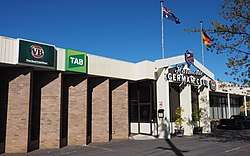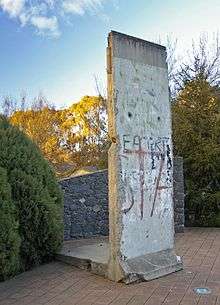Harmonie German Club
The Harmonie German Club is a social club in Canberra, Australia founded and built by German migrants, including the "Jennings Germans", in the early 1960s. In the mid 1960s migrants and their children made up half of Canberra's 80,000 population. Community clubs, including for example those founded by Italian, German and Polish migrants, were recognised as important for welcoming new settlers, providing venues to socialise and reminisce.[1]

Background
From the laying of its foundation stone in 1913, the progress of building Canberra, the new capital city of Australia, was slow. The First World War, the Great Depression and then the Second World War meant resources for construction were limited. After the 1939-45 War suburban growth was essential to house the public servants whose Commonwealth Departments were moving to the nation's administrative centre. The population grew from around 17,000 in 1947 to over 30,000 in 1954.[2] Skilled tradespeople were in severe shortage and housing construction firm A V Jennings was forced to seek carpenters from Germany.[3]
The Jennings Germans
A V Jennings was contracted by the government in 1950 to build 1850 homes but the limited availability of local tradesmen led to sourcing qualified migrants. Canberra's Technical College building trades head and an interpreter travelled to Germany to test and recruit 150 men from the 2,500 men who had responded to advertisements. The men arrived in Australia on two year contracts and commenced work in January 1952. Within the two years, 1800 new houses had been completed. Around 100 of the men chose to stay in Australia when their contracts were over. They were known as the Jennings Germans.[4]
Club foundation

Those Jennings Germans still in Canberra, along with other German expatriates, including some who had migrated to Australia to work on the Snowy Mountains Scheme,[5] founded the Harmonie German Club in the Canberra suburb of Narrabundah.[6]
Work on the club began in August 1962 and was built by volunteer labour. The foundation stone was laid in 1963[7] and the club was opened a year later.[8] In 1972 it was extended, becoming the largest of Canberra's migrant clubs.[6]
In 1992 a section of the Berlin Wall was installed outside the club.[9]
Reunions
Jennings Germans have attended reunions at the club since 1965.[10] Albert Jennings attended the 25th anniversary of their arrival, in 1977. Minister for Immigration and Ethnic Affairs, Michael MacKellar wrote to congratulate their success "One would have to look far to find a better example of migration to Australia than that of the 150 German carpenters who arrived in Canberra 25 years ago... [They] faced their difficulties, built their houses and, fortunately for us, most of them decided to stay and build their lives here too."[6]
Canberra Oktoberfest
In 1963 a group of Jennings Germans expats from Munich instigated Canberra's annual three-day Oktoberfest and the club has organised it every year since. The festival includes such traditional German celebrations as folk dancing, bands, food and beers. It has attracted attendances of up to 25,000.[11] The festivities outgrew the club's facilities and in 2017 Oktoberfest was staged in nearby Queanbeyan.[12]
References
- "Migrants: are they happy?". The Canberra Times. 39 (11, 057). Australian Capital Territory, Australia. 19 January 1965. p. 2. Retrieved 1 December 2017 – via National Library of Australia.
- "Year Book Australia, 1963". Australian Bureau of Statistics. 25 January 1963. Retrieved 2 December 2017.
- "Canberra House Mid-century modernist architecture". Canberra House. 5 November 2006. Archived from the original on 22 July 2012. Retrieved 3 December 2017.
- Muenstermann, Ingrid (2015). Some Personal Stories of German Immigration to Australia since 1945. Xlibris. p. 2.2. ISBN 9781503503144.
- Thistleton, John (4 August 2014). "One sourpuss can close a club, says Harmonie chief". Canberra Times. Retrieved 3 December 2017.
- "Book Two Sunday Features". The Canberra Times. 66 (20, 762). Australian Capital Territory, Australia. 16 February 1992. p. 17. Retrieved 2 December 2017 – via National Library of Australia.
- "German Club Stone Laid". The Canberra Times. 38 (10, 678). Australian Capital Territory, Australia. 28 October 1963. p. 9. Retrieved 1 December 2017 – via National Library of Australia.
- "German club opened". The Canberra Times. 39 (10, 968). Australian Capital Territory, Australia. 5 October 1964. p. 7. Retrieved 1 December 2017 – via National Library of Australia.
- Vyver, Ben (8 May 2014). "A piece of peace: the Berlin Wall in Canberra". 666 ABC Canberra. Retrieved 11 February 2018.
- "German reunion this weekend". The Canberra Times. 46 (13, 085). Australian Capital Territory, Australia. 31 March 1972. p. 3. Retrieved 2 December 2017 – via National Library of Australia.
- "'Our Festival for the People of Canberra' Harmonie German Club wants city involvement to grow". The Canberra Times. 52 (14, 905). Australian Capital Territory, Australia. 13 October 1977. p. 21. Retrieved 2 December 2017 – via National Library of Australia.
- Williams, Elliot (28 October 2017). "Queanbeyan hosts first Oktoberfest after 50 years in Canberra". The Canberra Times. Retrieved 3 December 2017.